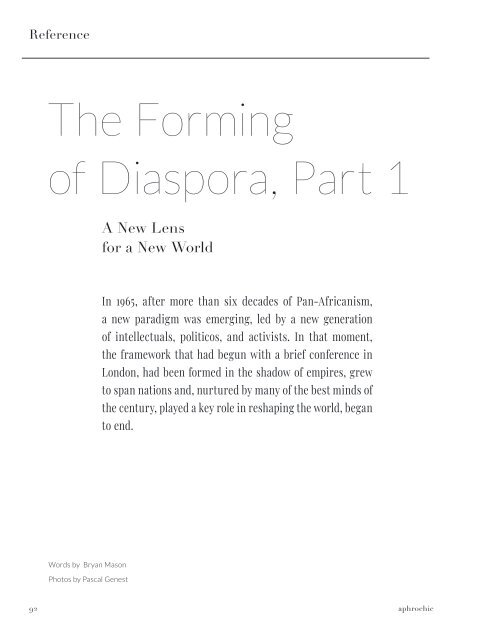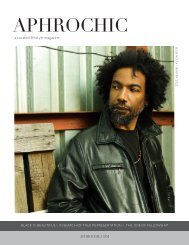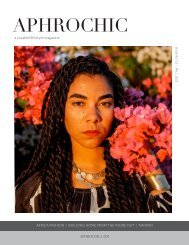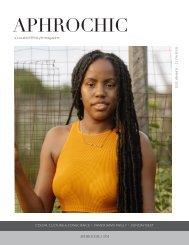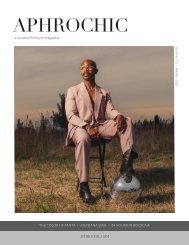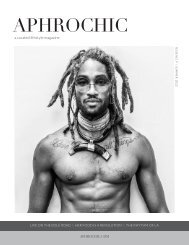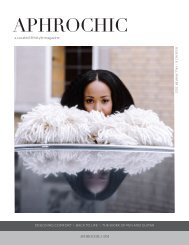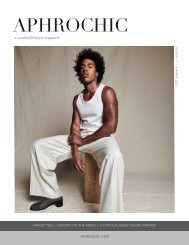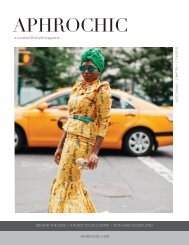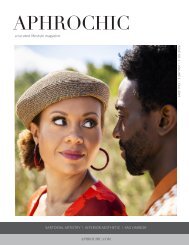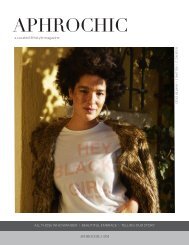AphroChic Magazine: Issue No. 5
This issue celebrates the things about Black culture that are enduring, and that can’t be altered by one bad year - our resilience, our creativity and our radical joy. In the pages of this issue we’ll be sharing with you the visionary work that is taking place every day in our Diaspora. We’ll introduce you to a growing community of Black home brewers who are creating their own space in craft brewing. Then we’re off for a photo tour of beautiful Tanzania. We’ll look at the modern work of South African artists Faatimah Mohamed-Luke and Al Luke, and for the holidays, we’ll share with you our modern take on the Pan-Africanist celebration of Kwanzaa. In issue 5 we are thrilled to take you to the hottest decor boutique in Germany, created and designed by our cover star Chris Glass. Then we’ll give you a sneak peek into our latest project - AphroFarmhouse. And our hot topic is an important discussion on the recession and how we can craft an economic plan that puts Black people first. While we are excited to show you all that’s beautiful around the Diaspora, we also want to share with you the reason why we do this work - to educate, uplift and give back. This holiday season we’re excited to let you know about our partnership with (RED) on an exclusive collection of pillows and tabletop to raise awareness and critical funds for the world’s most vulnerable communities impacted by HIV/AIDS and now COVID-19. And you’ll find more amazing products that support Black businesses in our expansive Mood gift guide.
This issue celebrates the things about Black culture that are enduring, and that can’t be altered by one bad year - our resilience, our creativity and our radical joy. In the pages of this issue we’ll be sharing with you the visionary work that is taking place every day in our Diaspora. We’ll introduce you to a growing community of Black home brewers who are creating their own space in craft brewing. Then we’re off for a photo tour of beautiful Tanzania. We’ll look at the modern work of South African artists Faatimah Mohamed-Luke and Al Luke, and for the holidays, we’ll share with you our modern take on the Pan-Africanist celebration of Kwanzaa.
In issue 5 we are thrilled to take you to the hottest decor boutique in Germany, created and designed by our cover star Chris Glass. Then we’ll give you a sneak peek into our latest project - AphroFarmhouse. And our hot topic is an important discussion on the recession and how we can craft an economic plan that puts Black people first.
While we are excited to show you all that’s beautiful around the Diaspora, we also want to share with you the reason why we do this work - to educate, uplift and give back. This holiday season we’re excited to let you know about our partnership with (RED) on an exclusive collection of pillows and tabletop to raise awareness and critical funds for the world’s most vulnerable communities impacted by HIV/AIDS and now COVID-19. And you’ll find more amazing products that support Black businesses in our expansive Mood gift guide.
You also want an ePaper? Increase the reach of your titles
YUMPU automatically turns print PDFs into web optimized ePapers that Google loves.
Reference<br />
The Forming<br />
of Diaspora, Part 1<br />
A New Lens<br />
for a New World<br />
In 1965, after more than six decades of Pan-Africanism,<br />
a new paradigm was emerging, led by a new generation<br />
of intellectuals, politicos, and activists. In that moment,<br />
the framework that had begun with a brief conference in<br />
London, had been formed in the shadow of empires, grew<br />
Words by Bryan Mason<br />
Photos by Pascal Genest<br />
to span nations and, nurtured by many of the best minds of<br />
the century, played a key role in reshaping the world, began<br />
to end.<br />
Yet the introduction of the African<br />
Diaspora concept by Joseph Harris and George<br />
Shepperson in 1965 was more than a rhetorical<br />
passing of the guard. It signified deep changes<br />
in the ways that Black people all over the world<br />
were seeing themselves in relationship to their<br />
homelands, to Africa as both continent and<br />
symbol, and to each other. Bringing all of that<br />
into focus would take more than one word.<br />
Much more. But before the African Diaspora<br />
could become real in the minds of those who<br />
would comprise it, it would first have to be<br />
formed and defined in ways that would meet the<br />
new needs of a changing time. Chief among the<br />
questions to be answered between Pan-Africanism<br />
and Diaspora was, what’s the difference?<br />
Among the many aspects that differentiate<br />
the two frameworks, perhaps the most<br />
significant is the basic way in which each conceptualizes<br />
the relationship between the individual<br />
Black person of any nationality, the<br />
continent of Africa, and the whole community<br />
of Black people worldwide. Any number of<br />
other differences exist, especially as Diaspora<br />
continues to work to define itself more fully.<br />
But this is most important, because it is on the<br />
foundation of these points that both philosophies<br />
build the entirety of their perspectives.<br />
Form and Function<br />
For Pan-Africanism, the basic foundation<br />
of its outlook is expressed in an idea that<br />
could loosely be described as “the underlying<br />
African self.” This idea posits that beneath<br />
the cultural specificities of any nationality<br />
or ethnicity, there exists an underlying,<br />
original or essential part of every Black person<br />
that connects us to the African continent and<br />
therefore to each other.<br />
Though the idea of an essential African-ness<br />
connecting all Black people might<br />
continue to resonate to a greater or lesser<br />
degree today, at the time it was all but common<br />
knowledge. During Pan-Africanism’s tenure<br />
there was no “African-American” as Jesse<br />
Jackson would popularize the term in the<br />
1980s, only the African (or more commonly,<br />
the Negro) in America. Black people in other<br />
parts of the world were thought of similarly,<br />
not as belonging to the place, regardless of<br />
where they were born, but as being the Negro<br />
here or there. The idea is even borne out in<br />
the title of Shepperson’s introductory article<br />
on Diaspora with its use of the phrase, “The<br />
92 aphrochic issue five 93


